Book contents
- Frontmatter
- Dedication
- Contents
- Preface
- Table of cases
- Table of legislation
- 1 Introduction: concepts and methodology
- 2 The English system of government
- 3 The US system of government
- 4 The Australian system of government
- 5 The development and institutional structure of control regimes
- 6 Administrative interpretation
- 7 Administrative fact-finding and policy-making
- 8 Administrative rule-making
- 9 Administrative adjudication
- 10 Private law controls
- 11 Controlling information
- 12 The New PublicManagement
- 13 Controlling the controllers
- 14 Concluding reflections on methodology and themes
- Bibliography
- Index
5 - The development and institutional structure of control regimes
Published online by Cambridge University Press: 05 March 2016
- Frontmatter
- Dedication
- Contents
- Preface
- Table of cases
- Table of legislation
- 1 Introduction: concepts and methodology
- 2 The English system of government
- 3 The US system of government
- 4 The Australian system of government
- 5 The development and institutional structure of control regimes
- 6 Administrative interpretation
- 7 Administrative fact-finding and policy-making
- 8 Administrative rule-making
- 9 Administrative adjudication
- 10 Private law controls
- 11 Controlling information
- 12 The New PublicManagement
- 13 Controlling the controllers
- 14 Concluding reflections on methodology and themes
- Bibliography
- Index
Summary
The previous three chapters have provided broad-brush, interpretive accounts of the systems of government of England, the United States and Australia, respectively, framed by the distinction between concentration and diffusion as models of the distribution of public power. In this chapter, we move on to control regimes. A control regime, it will be recalled, regulates the exercise of administrative power. It is a sub-system of a system of government consisting (like the latter) of a set of institutions, norms and practices. The aim of this chapter is to trace (in a broad-brush and interpretive fashion) the development of the control regimes of England, the United States and Australia, focusing on their institutional elements and associated practices. The account will be framed by the distinction between accountability and checks-and-balances as modes of controlling public power, particularly administrative power.
For purely expository purposes, it is useful to distinguish between three types of control of administrative power, which may be called political, legal and bureaucratic, respectively. Political control is concerned with the policy objectives and outcomes of administration; legal control addresses the question of whether or not administration is being conducted in accordance with law; and the concerns of bureaucratic control may be summarised in the classic ‘three Es’ of public auditing (economy, efficiency and effectiveness), and process values such as fairness, consistency and responsiveness. In considering control of public administration it is appropriate – from the end of the nineteenth century, anyway, and perhaps earlier in some contexts – to distinguish (as was done in Chapters 3 and 4) between the elected executive and the appointed bureaucracy.
England
Political control
In the mediaeval period, the ordinary English citizen's experience of public administration primarily involved contact with local officials and agencies, not central government. The central executive consisted of the Monarch and a very small cadre of close advisers and administrators whose main concerns were internal peace, national defence and foreign relations. The principle that the Monarch's power was not absolute but limited by law and custom, and conditional (to some extent at least) on the consent of a group of leading citizens, was politically potent in the thirteenth century and firmly established by the end of the fourteenth. It provided the basis for the more-or-less effective expression of grievances about the conduct of central government.
- Type
- Chapter
- Information
- Controlling Administrative PowerAn Historical Comparison, pp. 146 - 202Publisher: Cambridge University PressPrint publication year: 2016



